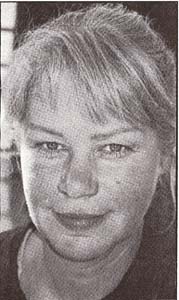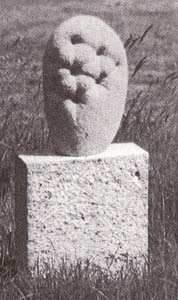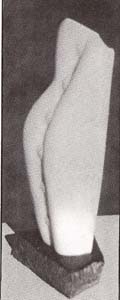 This is an interview with stone sculptor/artist Verena Schwippert at her
This is an interview with stone sculptor/artist Verena Schwippert at her
VS: That one (pointing to a 1+ ton boulder on a pallet) For three years I've been looking at that one.
SS: What are your plans for this one?
VS: I think I'll use this for one of my "vessels" (large granite' boulders shaped into vessel or urn shapes, often set in groups) Although this form offers itself for thousands of ideas: a big "chair," "bowl," but I think a "vessel" would be just great. Even if I never work that stone, it's georgous, with such a coarse grain, very uniform too.
(We look at her granite water basin, with flowing pattern down one side, set on a granite base.)
VS: I'm going to set a water tap by it for use as an outside hand wash basin, This is white granite (from Mark Heisel). It's the hardest granite I've ever worked. It took me about a day and a half to make the bowl shape. I worked the inside shape with the ripper bit. And I broke a ripper on it.
SS: It looks like you're working a lot in granite.
VS: I love granite. (We wander by a large vertical slab, "The Rune Stone," approx. 2'x4'. One side is ringed by an inscription in ancient Norse runes.) Even before I knew what it meant, I liked the way the script interacted with the natural stone surface. There are parts that I am still developing and maybe I'll develop these lines (chalk lines on the piece). I like how the natural stone is curved. I might not touch that. And this surface, to do something to it bothers me, but I want to do something. The holes (through the piece) and these lines are touching on the water theme. This inscription is an old Nordic rune which I researched at the library. Then I wrote this inscription for the 
(Again we go into her home-an open space full of her paintings and sculpture and her collection of work by other artists. Her painting studio is in a large back room, although she says she hasn't painted much recently.)
SS: Have you shifted away from painting? (She had been painting for thirty-five years).
VS: Totally. I had painted realistically, but at the moment, I decided to work more in the abstract style; that's when I started working on stone. Oddly enough, the special thing about sculpture is that it's always "real." This (a realistic painting) isn't real. It's an abstraction with two dimensions only. A three dimensional object is real is "realism", per se.
SS: Is it a brain-shift moving from the painter to the sculptor
VS: Not for me because I always had a want or need to express three dimensions, even in the paintings. As a child I played with clay and had an attraction toward three dimensions. I just didn't know how to do stone work. Finally I was taught.
SS: How long have you been living the artist's life?
VS: I remember doing a good drawing at three years old and no one in the family believed I did it. In school I drew all the time during lessons. I studied art at the
I have to do art to feel fulfilled. And art is never just for your own fulfillment because other people look at it. You always convey something, an expression, a feeling of form. I have a degree in art teaching. I do hope in my sculpture there's a little wakeup call: a certain form that's good or a new way of looking at things. It's my purpose in life. I was given the talent and the desire. Of course, you have to learn a lot.
SS: When you work with a piece of material that already has a predominate shape, texture, size, and maybe is "perfect," how do you think that relates to art? If there is something that already has a presence to it, as an artist, how do you interact with that form?
VS: A good definition would be that humans make art. The shapes you find in nature makes. This can be a helpful definition. I have been in situations where I had too much respect for the stone, the surface, the natural qualities, which are already so beautiful. Whatever we do to it could diminish or destroy its beauty. It's difficult to elevate the natural form. That's what Uchida (sculptor Kazntaka Uchida) is so good at. He takes those natural forms and is able to enhance them. His pieces look so utterly disciplined but also very natural.
I like to invent things. I had a tongue-shaped stone and I quilted it-made a mattress-look out of it. It made the stone look soft. I like to invent these new marks and forms on the stone, like the "toot-horns" around the drill holes (as on the Rune Stone). We were told at art school to find our own language and our personal mark in our art.
I've been carving stone for five years. I started out by going to Nicky Oberholtzer's class. She introduced me to this group. In all my years as an artist, I have never found a group of artists who are so supportive of each other. I've gotten so much help from people. At the symposia you learn so much; you're pushed on the way. I wanted to work in stone. I never dreamed it could be in granite.
SS: So you learned to go beyond seeming barriers?
VS: It was not so much giving me the courage to do the work, but giving me the tools and know-how. The artistic momentum is not from the group (NWSSA). I worked painting for 35 years, trying to sell and make myself paint. I've learned after two decades of lollygagging around to go to it; do it even though you don't want to because after five minutes into the process, you'll love it. You have to push yourself to get into it.
My work schedule is not regular by the clock, but I've set it up so that, every day I'm at home, I should be able to work in stone. For me, the everyday life is working on the stone, not cleaning the house, not washing the dishes. I like the chaos, I like the dirt. I like to let it go at limes, otherwise I don't feel like I'm living.
I work at a job 48 hours a week straight. doing elder care. With that I pay my bills and have freedom to create my art.
I have made money from my art, but I don't see my art as a business. I want to have the freedom to play. You discover things which you only find by playing. You play with the shapes and the tools. You try this; you try that.
SS: What artists influence or inspire your work?
VS: I've probably been influenced by every artwork I've ever seen, also by the never ending variety of natural forms.
Three artists whose work I admire are Tillman Riemenschneider, ca. 1250; Ernst Barlach who worked 1920-60; and Henry Moore, whom I admire immensely. All have worked with the human figure using a varying degree of abstraction. (We sit on the porch and look at an art book about one of Verena's influences-stone sculptor Lika Mutal ) She communicates with the stone.
SS: How do you relate to Lika Mutal's notion of "communicating with the stone"?
VS: There are some situations where I feel I get touched by the essence, but it's very fleeting and rare. I like it. It's almost a spiritual experience. All of a sudden you feel and are aware of the power within the stone, when you cut, when you saw into it and it screams. That's what the "stone vessels" are about. They underline that power that is in the stone. It has a life. It's not a lifeless mass to me. The rocks are the bones of the earth and we play with those bones.
SS: What scale or size do you like to work in?
VS: Size 12. (laughter). For relaxation and recreation between my larger works, I do "two day" sculptures. I make them in two days. They're no larger than 18", easily moveable, they are "play" pieces, trial pieces. And I am interested in working in large scale, REALLY LARGE scale!
SS: Do these "two day" pieces become ideas for other pieces?
VS: They have inspired other pieces. They have shown the way to other venues. And they make great gifts.
SS: What is your relationship to selling your work?
VS: Some pieces are easier to let go of than others. I like to sell them, though I don't beat the drum about selling them. A recent conviction of mine: if some one gives me their hard-earned money for my art, it's a great compliment. I used to think that money was diluting my idealism, or my pure intentions. Money is probably more neutral, really.
SS: In terms of your livelihood?
VS: I don’t want to "have to " count on it. I've arranged my life so I don't have to do that. Somehow that makes it easier. And you are able to create better things. I have developed shows, worked with deadlines and that can be a good thing, but I wouldn't want it all the time.
SS: (We look at photos of her "Stone Vessel Group: Tau": four large granite vessel forms on a black base. Tau in German means lithe dew," "dew drops".) Tell me about the "Stone Vessels". How long have you been working with that idea?
VS: A year and a half. It's an attention getter. I started with a small vase shape and then got bigger and bigger and bigger. Each rock that has a rounded shape becomes really quite different in character. It's very easy do. I could line my driveway with bags and they would all be different, it would look wonderful. Actually they contain something, the rock, they contain time and power. They are bags of mountain power.
SS: We end the interview talking about the large collaborative piece done at the '97 symposium with Ruth Mueseler and Tamara Buchanan. The idea came from Ruth, who suggested that we do a large piece together. We picked a stone at Marenakos Stone Yard which looked good and turned out to be a ton's worth. In the pile of huge stones it looked little. Rich Hestekind hauled it up to the symposium. It started from a small idea, then there it was. We were so busy with the technicalities of setting the stone that we didn't have a chance to think about shaping the piece 'til late in the week. It was difficult to find a quiet space to work on the design. Six or seven days into the symposium the piece was mounted on the base. The design was prescribed by the rock. We now work with all outline of a design which we all agreed on, allowing it to change as we go along. The working title is "Going With the Flow" because that's what the process had been, although sometimes a turbulent flow. We started shaping the piece at the symposium, eventually transporting it to the History of The World Part 4 gallery on
SS: So, a work in progress continues. Thauks, Verena, this has been fun.
